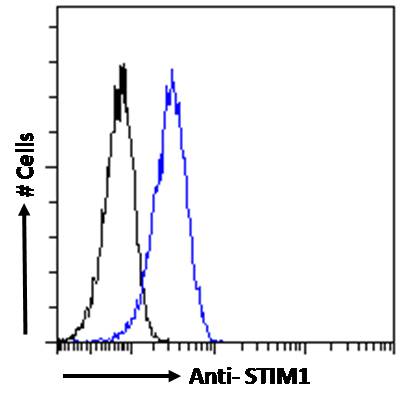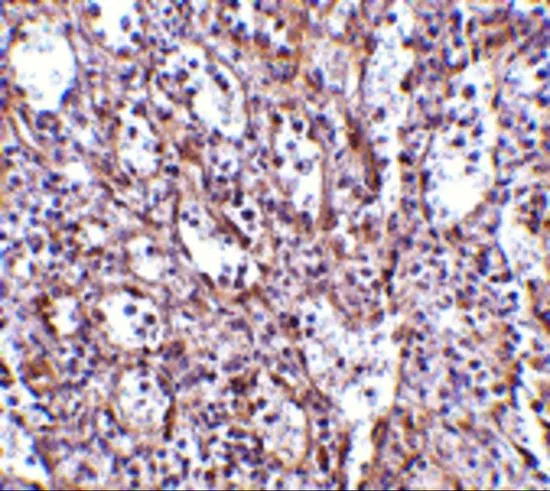![WB analysis of RBL cell lysates (non-reducing) using GTX80195 STIM1 antibody [CDN3H4]. Lane 1 : GTX80195 Lane 2 : mouse IgG1 isotype control WB analysis of RBL cell lysates (non-reducing) using GTX80195 STIM1 antibody [CDN3H4]. Lane 1 : GTX80195 Lane 2 : mouse IgG1 isotype control](https://www.genetex.com/upload/website/prouct_img/normal/GTX80195/GTX80195_20191025_AP_001_418_w_23061322_102.webp)
WB analysis of RBL cell lysates (non-reducing) using GTX80195 STIM1 antibody [CDN3H4]. Lane 1 : GTX80195 Lane 2 : mouse IgG1 isotype control
STIM1 antibody [CDN3H4]
GTX80195
ApplicationsImmunoFluorescence, ImmunoPrecipitation, Western Blot, ImmunoCytoChemistry, ImmunoHistoChemistry, ImmunoHistoChemistry Paraffin
Product group Antibodies
ReactivityHuman, Mouse, Rat
TargetSTIM1
Overview
- SupplierGeneTex
- Product NameSTIM1 antibody [CDN3H4]
- Delivery Days Customer9
- ApplicationsImmunoFluorescence, ImmunoPrecipitation, Western Blot, ImmunoCytoChemistry, ImmunoHistoChemistry, ImmunoHistoChemistry Paraffin
- CertificationResearch Use Only
- ClonalityMonoclonal
- Clone IDCDN3H4
- Concentration1 mg/ml
- ConjugateUnconjugated
- Gene ID6786
- Target nameSTIM1
- Target descriptionstromal interaction molecule 1
- Target synonymsD11S4896E, GOK, IMD10, STRMK, TAM, TAM1, stromal interaction molecule 1
- HostMouse
- IsotypeIgG1
- Protein IDQ13586
- Protein NameStromal interaction molecule 1
- Scientific DescriptionThis gene encodes a type 1 transmembrane protein that mediates Ca2+ influx after depletion of intracellular Ca2+ stores by gating of store-operated Ca2+ influx channels (SOCs). It is one of several genes located in the imprinted gene domain of 11p15.5, an important tumor-suppressor gene region. Alterations in this region have been associated with the Beckwith-Wiedemann syndrome, Wilms tumor, rhabdomyosarcoma, adrenocrotical carcinoma, and lung, ovarian, and breast cancer. This gene may play a role in malignancies and disease that involve this region, as well as early hematopoiesis, by mediating attachment to stromal cells. Mutations in this gene are associated with fatal classic Kaposi sarcoma, immunodeficiency due to defects in store-operated calcium entry (SOCE) in fibroblasts, ectodermal dysplasia and tubular aggregate myopathy. This gene is oriented in a head-to-tail configuration with the ribonucleotide reductase 1 gene (RRM1), with the 3 end of this gene situated 1.6 kb from the 5 end of the RRM1 gene. Alternative splicing of this gene results in multiple transcript variants. [provided by RefSeq, May 2013]
- ReactivityHuman, Mouse, Rat
- Storage Instruction2°C to 8°C
- UNSPSC12352203

![ICC/IF analysis of methanol-aceton fixed HeLa cells using GTX80195 STIM1 antibody [CDN3H4]. Red : Primary antibody Blue : DAPI ICC/IF analysis of methanol-aceton fixed HeLa cells using GTX80195 STIM1 antibody [CDN3H4]. Red : Primary antibody Blue : DAPI](https://www.genetex.com/upload/website/prouct_img/normal/GTX80195/GTX80195_20191025_AP_002_417_w_23061322_717.webp)



![Various whole cell extracts (30 microg) were separated by 7.5% SDS-PAGE, and the membrane was blotted with STIM1 antibody [SD0814] (GTX01149) diluted at 1:500. The HRP-conjugated anti-rabbit IgG antibody (GTX213110-01) was used to detect the primary antibody. Corresponding RNA expression data for the same cell lines are based on Human Protein Atlas program.](https://www.genetex.com/upload/website/prouct_img/normal/GTX01149/GTX01149_HJ1017_20200228_WB_TPM_watermark_w_23053121_643.webp)

